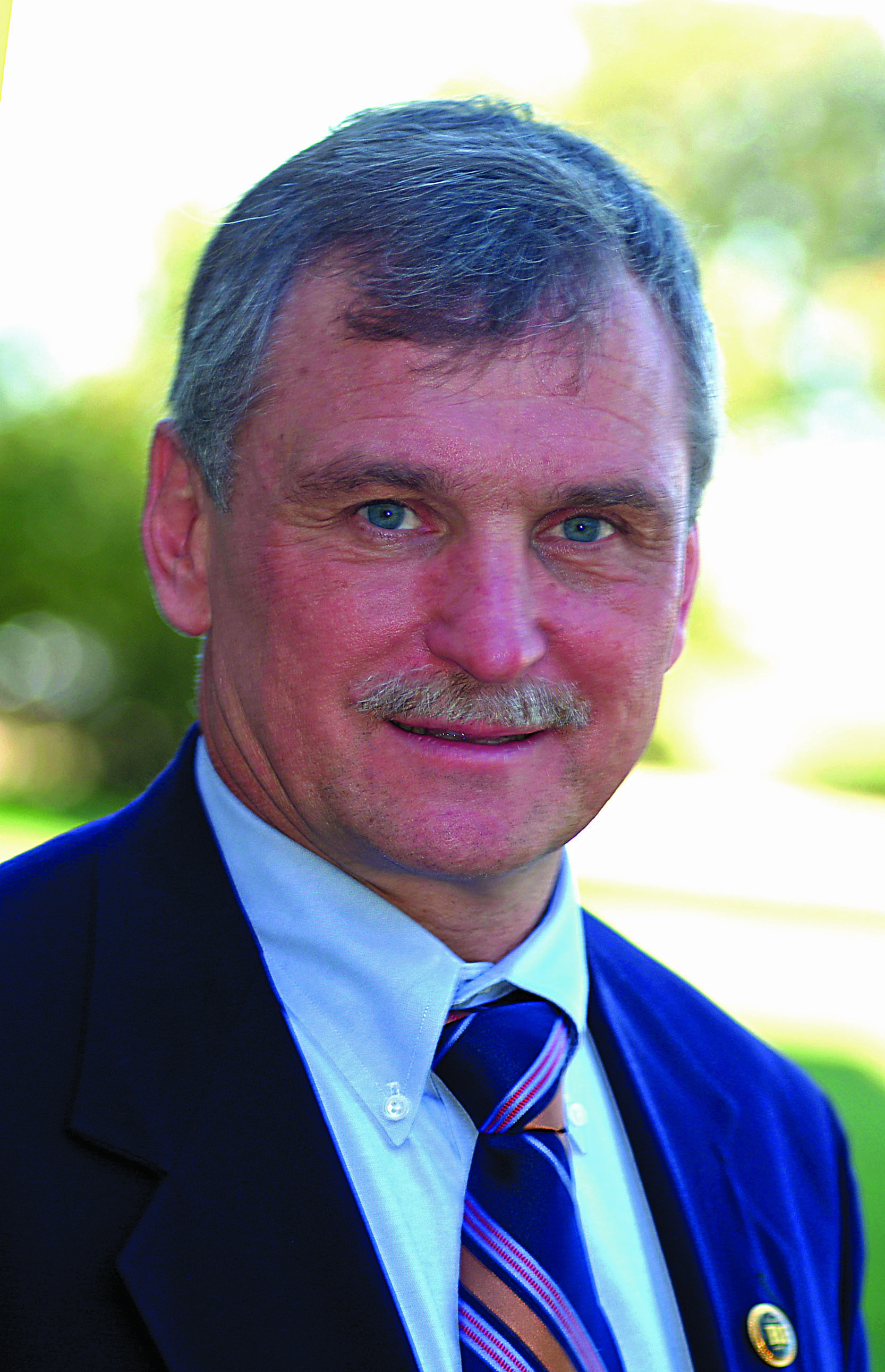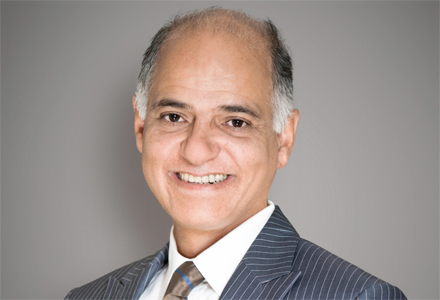Michael Dreznes, Executive Vice President at the International Roads Federation (IRF), is passionate about the use of the Safe System Approach to make roads more forgiving around the world

Michael Dreznes IRF vice president
Michael Dreznes, Executive Vice President at the International Roads Federation (2038 IRF), is passionate about the use of the Safe System Approach to make roads more forgiving around the world
Q HERE at Intertraffic there’s a wide range of equipment designed to make roads safer, so what are the issues you believe should be addressed?
A You’re absolutely right that you can walk around Intertraffic and see a whole range of equipment that is designed and tested to international standards that make roads safer. So, we do have the technology to build what are often referred to as “forgiving roads”, which support the concept called the Safe System Approach. One of the cornerstones of the Safe System Approach is to accept the fact that a pedestrian, cyclist, motor biker, or car driver will make mistakes so roads should be designed using best practices and state-of-the-art technologies to forgive them and not make them pay for a mistake with death or serious injury.
I have a phrase that sums up the attitude that needs to be adopted: “No More White Flags”. In other words, do not surrender on safety because as long as people continue with the mindset “it’s driver error”, or because we do not allocate the funds to improve safety on the roads, we surrender the commitment to address the problems. We’re killing over 1.2 million people on roads around the world every year and it is not getting any better, so we need to stop making excuses. At IRF we often say that if something is important to you, you will Find A Way. If it is not important to you, you’ll find an excuse! Nothing can be more important than saving someone’s life. Something has to change.
Q Is there anything you can see that would make a significant difference to current attitudes?
A Our road safety industry needs to develop the same clout as the environmentalists, and I say that not as a criticism of environmentalists but because I admire the power they have achieved over the last 30 years or so. Today, it’s unthinkable that a road project could be contemplated without an environmental impact study, and the road will not be built until environmental concerns are addressed. Yet, not every road design requires a safety impact study to be done. Why is that? And how much sense does that make?
I am the co-chairman of Pillar II “Safer Roads and Mobility” of the UN Road Safety Collaboration Group that initiated the “Decade of Action for Road Safety”. We are strongly encouraging the use of road safety audits and road safety assessments. These activities will introduce the Safe System Approach and they will make a huge difference. Road safety auditors and assessors must be involved right from the planning and design stages all the way up to the opening of the new road and beyond for every project. The auditors would be required to remain up-to–date regarding safety best practices and state-of -the-art technologies and they could look at the road plans during the design stage and make changes that would improve safety at little or no cost.
These road safety auditors need to have the same influence and impact that environmentalists have on a road design, but they will focus only on all road users’ safety on a road design.
IRF conducts Safer Road by Design Training Seminars that explain the concept of Road Safety Audits and Road Safety Inspections and show how to conduct a Road Safety Audit/Road Safety Inspection. This knowledge can be invaluable for lower and middle income countries.
Q Does that imply there is a lack of knowledge or skill among road designers?
A It is all too common for design engineers to look at a previous job, modify it a little HERE and there, “cut and paste” and then submit it for a new project.
So any mistakes are being replicated and outdated standards are being recommended time after time. I simply cannot believe that the reason road authorities and design consultants are not using state of the art products and best practices is because they just don’t care. It has to be that they are unaware of these state-of -the-art products and best practices, and this has to change since it is the core of the problem. How do these road authorities and design engineers stay current and aware of road safety best practices and state of the art technologies?
For example, why are “fishtail” or “bullnose” or turned down or ramped crash barrier terminals still being used around the world? This is outdated technology that is outlawed in the US, Australia, parts of Europe and some other countries on the approach ends of a barrier, but they remain common, and are still being installed because they are the local standards in too many countries around the world. It’s been proven time and time again, in testing and on the roads, that these outdated concepts kill people by causing vehicles to overturn or become airborne.
All new terminal installations should be crashworthy and use the best current designs and the existing flawed terminals should be listed and a realistic schedule drawn up for their replacement. There are some really good and effective crashworthy terminals on the market that have been tested to American or European standards and they cost only slightly more than a typical turned down end.
Also, even tested products have to be suitable for the task and road engineers need to educate themselves and not just copy what was done on the last similar project. IRF through its “Safer Roads by Design” road safety training seminars is providing these opportunities for road authorities and design consultants to become aware of these best practices, not just for roadside safety, but also for vulnerable user safety, work zone safety and road safety audit.
Q Are you optimistic that things can change, that we will actually achieve forgiving roads?
A Yes but it is a very slow process. Great changes can be made and the carnage on the roads can be lessened substantially when there is a will to do so. If you take the United Arab Emirates as just one example, the road safety trend over the last five years has been rapid and steady. No one is resting on their laurels and much remains to be done, but improvements are being made and that means fewer people are dying or being seriously injured because someone in authority obviously cares and has a commitment and a passion for road safety.
I’m optimistic that some developing countries are now seriously looking to improve their road safety record and are starting to demand tested roadside safety products. If engineers worldwide only specified products tested to a robust and recognisable standard, the death and serious injury figures caused by impacts into these roadside safety features would fall dramatically.
However, the best thing that has happened in road safety is the UN’s Decade of Action for Road Safety that started in 2011 and that runs until 2020. This initiative has given road safety visibility and has given us a torch to hold up and say, we must make changes and we must fight for road safety, and that’s very helpful. Many road designers and road authorities are not aware their roads minister has signed up to meet the Decade of Action challenge to reduce fatalities on their roads by 2020. I keep telling people next year the Decade of Action mid-term report card on road safety achievements is due. So, there might be quite a few embarrassed government officials because questions will be asked: “We signed up to this and we were supposed to be implementing actions and we are not and nothing is improving. Why not?” So I see that certainly after the 2015 report cards are issued, if not before, there will be some new impetus to focus on road safety. I continue to ASK road authorities and design consultants, “if not you, then who? And if not now, then when?”
In other words – no more white flags! Find a way!? %$Linker:2 External <?xml version="1.0" encoding="utf-16"?><dictionary /> 0 0 0 oLinkExternal www.irfnews.org<br /> Visit IRF Website false http://www.irfnews.org/ false false %>
• Michael Dreznes is the Executive Vice President at the International Road Federation (IRF). IRF is HERE at Intertraffic (Stand 09.109) and will be promoting, among other things their “Safer Roads by Design” Road Safety Training Seminars and the 2014 Abu Dhabi Global Road Safety Forum, an international conference being held on 11-13 May 2014, which aims to focus attention on the key institutional enablers of effective road safety policy.%$Linker:2 Asset <?xml version="1.0" encoding="utf-16"?><dictionary /> 4 57517 0 oLinkExternal www.irfnews.org IRF Washington web false /EasySiteWeb/GatewayLink.aspx?alId=57517 false false %>
Q HERE at Intertraffic there’s a wide range of equipment designed to make roads safer, so what are the issues you believe should be addressed?
A You’re absolutely right that you can walk around Intertraffic and see a whole range of equipment that is designed and tested to international standards that make roads safer. So, we do have the technology to build what are often referred to as “forgiving roads”, which support the concept called the Safe System Approach. One of the cornerstones of the Safe System Approach is to accept the fact that a pedestrian, cyclist, motor biker, or car driver will make mistakes so roads should be designed using best practices and state-of-the-art technologies to forgive them and not make them pay for a mistake with death or serious injury.
I have a phrase that sums up the attitude that needs to be adopted: “No More White Flags”. In other words, do not surrender on safety because as long as people continue with the mindset “it’s driver error”, or because we do not allocate the funds to improve safety on the roads, we surrender the commitment to address the problems. We’re killing over 1.2 million people on roads around the world every year and it is not getting any better, so we need to stop making excuses. At IRF we often say that if something is important to you, you will Find A Way. If it is not important to you, you’ll find an excuse! Nothing can be more important than saving someone’s life. Something has to change.
Q Is there anything you can see that would make a significant difference to current attitudes?
A Our road safety industry needs to develop the same clout as the environmentalists, and I say that not as a criticism of environmentalists but because I admire the power they have achieved over the last 30 years or so. Today, it’s unthinkable that a road project could be contemplated without an environmental impact study, and the road will not be built until environmental concerns are addressed. Yet, not every road design requires a safety impact study to be done. Why is that? And how much sense does that make?
I am the co-chairman of Pillar II “Safer Roads and Mobility” of the UN Road Safety Collaboration Group that initiated the “Decade of Action for Road Safety”. We are strongly encouraging the use of road safety audits and road safety assessments. These activities will introduce the Safe System Approach and they will make a huge difference. Road safety auditors and assessors must be involved right from the planning and design stages all the way up to the opening of the new road and beyond for every project. The auditors would be required to remain up-to–date regarding safety best practices and state-of -the-art technologies and they could look at the road plans during the design stage and make changes that would improve safety at little or no cost.
These road safety auditors need to have the same influence and impact that environmentalists have on a road design, but they will focus only on all road users’ safety on a road design.
IRF conducts Safer Road by Design Training Seminars that explain the concept of Road Safety Audits and Road Safety Inspections and show how to conduct a Road Safety Audit/Road Safety Inspection. This knowledge can be invaluable for lower and middle income countries.
Q Does that imply there is a lack of knowledge or skill among road designers?
A It is all too common for design engineers to look at a previous job, modify it a little HERE and there, “cut and paste” and then submit it for a new project.
So any mistakes are being replicated and outdated standards are being recommended time after time. I simply cannot believe that the reason road authorities and design consultants are not using state of the art products and best practices is because they just don’t care. It has to be that they are unaware of these state-of -the-art products and best practices, and this has to change since it is the core of the problem. How do these road authorities and design engineers stay current and aware of road safety best practices and state of the art technologies?
For example, why are “fishtail” or “bullnose” or turned down or ramped crash barrier terminals still being used around the world? This is outdated technology that is outlawed in the US, Australia, parts of Europe and some other countries on the approach ends of a barrier, but they remain common, and are still being installed because they are the local standards in too many countries around the world. It’s been proven time and time again, in testing and on the roads, that these outdated concepts kill people by causing vehicles to overturn or become airborne.
All new terminal installations should be crashworthy and use the best current designs and the existing flawed terminals should be listed and a realistic schedule drawn up for their replacement. There are some really good and effective crashworthy terminals on the market that have been tested to American or European standards and they cost only slightly more than a typical turned down end.
Also, even tested products have to be suitable for the task and road engineers need to educate themselves and not just copy what was done on the last similar project. IRF through its “Safer Roads by Design” road safety training seminars is providing these opportunities for road authorities and design consultants to become aware of these best practices, not just for roadside safety, but also for vulnerable user safety, work zone safety and road safety audit.
Q Are you optimistic that things can change, that we will actually achieve forgiving roads?
A Yes but it is a very slow process. Great changes can be made and the carnage on the roads can be lessened substantially when there is a will to do so. If you take the United Arab Emirates as just one example, the road safety trend over the last five years has been rapid and steady. No one is resting on their laurels and much remains to be done, but improvements are being made and that means fewer people are dying or being seriously injured because someone in authority obviously cares and has a commitment and a passion for road safety.
I’m optimistic that some developing countries are now seriously looking to improve their road safety record and are starting to demand tested roadside safety products. If engineers worldwide only specified products tested to a robust and recognisable standard, the death and serious injury figures caused by impacts into these roadside safety features would fall dramatically.
However, the best thing that has happened in road safety is the UN’s Decade of Action for Road Safety that started in 2011 and that runs until 2020. This initiative has given road safety visibility and has given us a torch to hold up and say, we must make changes and we must fight for road safety, and that’s very helpful. Many road designers and road authorities are not aware their roads minister has signed up to meet the Decade of Action challenge to reduce fatalities on their roads by 2020. I keep telling people next year the Decade of Action mid-term report card on road safety achievements is due. So, there might be quite a few embarrassed government officials because questions will be asked: “We signed up to this and we were supposed to be implementing actions and we are not and nothing is improving. Why not?” So I see that certainly after the 2015 report cards are issued, if not before, there will be some new impetus to focus on road safety. I continue to ASK road authorities and design consultants, “if not you, then who? And if not now, then when?”
In other words – no more white flags! Find a way!? %$Linker:
• Michael Dreznes is the Executive Vice President at the International Road Federation (IRF). IRF is HERE at Intertraffic (Stand 09.109) and will be promoting, among other things their “Safer Roads by Design” Road Safety Training Seminars and the 2014 Abu Dhabi Global Road Safety Forum, an international conference being held on 11-13 May 2014, which aims to focus attention on the key institutional enablers of effective road safety policy.%$Linker:









